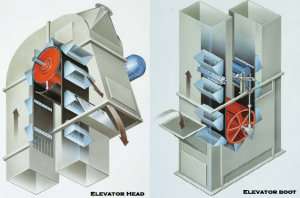Screw conveyor for bulk materials handling
Basically, Screw Conveyors are meant to move or say transport bulk material. It is cost-effective with low maintenance. Due to such advantages, Screw Conveyors are gaining popularity and are in great demand in various industrial applications.In the market, the Screw Conveyors are available in different shapes and sizes, as per the customer requirement or say they are tailored made to meet specific needs
Screw conveyors are made up of Stainless Steel to avoid rusting and serve for a longer period of time effectively. A helical screw blade inside the tube serves the main purpose, used in the screw conveyor for making the process of moving easy with coarse materials. This machine is fed with the materials at one end, which gets released at another end by the process of positive displacement. The coiled spiral blade around the rod is directed at one end and held at the other.
To serve the basic function of Screw conveyors, to transport bulk materials, many aspects has to be kept in mind. The screw conveyors manufacturers, have to manipulate and strive to design the best for the customers. The layout of the machine should be perfect with excellent service and easy access. The main aim is to meet the needs of customers by providing reliable and durable, cost-effective, and long-lasting.
Types of screw conveyor
Screw conveyors are basically of four types, which are used in the industries.
-
Horizontal Screw Conveyor
 Horizontal screw conveyors, these types of conveyors are used broadly used for construction material. They are used almost for all types of materials whether free-flowing, light, lumpy, or heavy. Neo conveyors, aggregate screw conveyors manufacturer India
Horizontal screw conveyors, these types of conveyors are used broadly used for construction material. They are used almost for all types of materials whether free-flowing, light, lumpy, or heavy. Neo conveyors, aggregate screw conveyors manufacturer India
2. Inclined Screw Conveyor
 Inclined screw conveyor– Their movement depends on the degree of inclination. The more it is inclined the lesser is the speed and its conveying efficiency.
Inclined screw conveyor– Their movement depends on the degree of inclination. The more it is inclined the lesser is the speed and its conveying efficiency.
3. Vertical Screw Conveyor
 Vertical screw conveyor– They are cost-effective and fit in any space, you can say they need less area. They are used in various industries, such as food, chemical, wastewater treatment plants, etc.
Vertical screw conveyor– They are cost-effective and fit in any space, you can say they need less area. They are used in various industries, such as food, chemical, wastewater treatment plants, etc.
4. Shaftless Screw Conveyor
 Shaftless screw conveyor– They are helpful in easy transfer of material due to its structure, as the surface of the conveyor is non-clogging material moves smoothly.
Shaftless screw conveyor– They are helpful in easy transfer of material due to its structure, as the surface of the conveyor is non-clogging material moves smoothly.
Neo conveyor other Products :
1. General Line Cans 2.Open Top Sainery Cans 3.Ring Lid &Tagger cans 4.Double Tight Ring & Lid Container 5.Easy Peel and Easy Open Cans








